사용자:배우는사람/문서:Prose Edda - Prologue (with notes)
PROLOGUE
편집I
편집Creation, Fall of man, and Great Flood
편집IN the beginning God created heaven and earth and all those things which are in them; and last of all, two of human kind, Adam and Eve, from whom the races are descended. And their offspring multiplied among themselves and were scattered throughout the earth. But as time passed, the races of men became unlike in nature: some were good and believed on the right; but many more turned after the lusts of the world and slighted God's command. Wherefore, God drowned the world in a swelling of the sea, and all living things, save them alone that were in the ark with Noah.
The same evil prevailed again after Noah's flood
편집After Noah's flood eight of mankind remained alive, who peopled the earth; and the races descended from them. And it was even as before: when the earth was full of folk and inhabited of many, then all the multitude of mankind began to love greed, wealth, and worldly honor, but neglected the worship of God.
They lost the name of God
편집Now accordingly it came to so evil a pass that they would not name God; and who then could tell their sons of God's mighty wonders? Thus it happened that they lost the name of God; and throughout the wideness of the world the man was not found who could distinguish (식별하다, 알아듣다[보다]) in aught (어떤 것) the trace of his Creator.
God bestow upon man both the gifts of the earth and an increase of wisdom
편집But not the less did God bestow upon them the gifts of the earth: wealth and happiness, for their enjoyment in the world; He increased also their wisdom, so that they knew all earthly matters, and every phase of whatsoever they might see in the air and on the earth.
On likes and unlikes of earth, beasts and birds
편집One thing they wondered and pondered over: what it might mean, that the earth and the beasts and the birds had one nature in some ways, and yet were unlike in manner of
[p. 4]
life.
Likes of earth, beasts and birds
편집First: Cleft into lofty mountain-peaks
편집In this was their nature one:
that the earth was cleft (쪼개다[가르다]) into lofty mountain-peaks, wherein water spurted up (뿜어져 나오다, 솟구치다), and it was not needful to dig longer for (…을 찾아 땅을 파다) water there than in the deep valleys;
so it is also with beasts and birds: it is equally far to the blood in the head and the feet.
Second: Grass and Flowers grow and wither every year
편집Another quality of the earth is, that in each year grass and flowers grow upon the earth, and in the same year all that growth falls away and withers;
it is even so with beasts and birds: hair and feathers grow and fall away each year.
Third: Grass grows straightway on the soil
편집This is the third nature of the earth, that when it is opened and dug up, the grass grows straightway (즉시, 즉각, 당장에) on the soil which is uppermost on the earth. Boulders and stones they likened to the teeth and bones of living beings.
Earth, sun and stars and their governor
편집Thus they recognized that the earth was quick, and had life with some manner of nature of its own; and they understood that she was wondrous old in years and mighty in kind: she nourished all that lived, and she took to herself all that died. Therefore they gave her a name, and traced the number of their generations from her.
The same thing, moreover, they learned from their aged kinsmen: that many hundreds of years have been numbered since the same earth yet was, and the same sun and stars of the heavens; but the courses of these were unequal, some having a longer course, and some a shorter.
From things like these the thought stirred within them that there might be some governor of the stars of heaven: one who might order their courses after his will; and that he must be very strong and full of might. This also they held to be true: that if he swayed the chief things of creation, he must have been before the stars of heaven; and they saw that if he ruled the courses of the heavenly bodies, he must also govern the shining of the sun, and the dews of the air, and the fruits of the earth, whatsoever grows
[p. 5]
upon it; and in like manner the winds of the air and the storms of the sea.
They knew not yet where his kingdom was; but this they believed: that he ruled all things on earth and in the sky, the great stars also of the heaven, and the winds of the sea.
The tradition: Wisdom of the earth
편집Wherefore (그런 이유로, 그러므로, 그런 까닭으로), not only to tell of this fittingly, but also that they might fasten it in memory, they gave names out of their own minds to all things. This belief of theirs has changed in many ways, according as the peoples drifted (떠가다, 표류[부유]하다) asunder (산산이; 뿔뿔이) and their tongues became severed one from another.
But all things they discerned with the wisdom of the earth, for the understanding of the spirit was not given to them; this they perceived, that all things were fashioned of some essence.
II
편집The world was divided into three parts: South (Africa), West (Europa) and Mediterranean (Asia)
편집The world was divided into three parts: from the south, extending into the west and bordering on the Mediterranean Sea,
Africa
편집--all this part was called Africa, the southern quarter of which is hot, so that it is parched (몹시 건조한[바싹 말라 버린]) with the sun.
Europa or Enea
편집The second part, from west to north and bordering on the ocean, is called Europa or Enea; its northern part is so cold that no grass grows upon it, and no man dwells there.
Asia
편집From the north and all down over the eastern part, even to the south, is called Asia. In that region of the world is all fairness and pride, and the fruits of the earth's increase, gold and jewels. There also is the centre of the earth; and even as the land there is lovelier and better in every way than in other places, so also were the sons of men there most favored with all goodly gifts: wisdom, and strength of the body, beauty, and all manner of knowledge.
[p. 6]
III
편집Troy and Turkland near the earth's center
편집Near the earth's centre was made that goodliest of homes and haunts (자주 가는[많은 시간을 보내는] 곳) that ever have been, which is called Troy, even that which we call Turkland. This abode was much more gloriously made than others, and fashioned with more skill of craftsmanship in manifold wise, both in luxury and in the wealth which was there in abundance.
Twelve kingdoms and one High King
편집There were twelve kingdoms and one High King, and many sovereignties belonged to each kingdom; in the stronghold were twelve chieftains. These chieftains were in every manly part greatly above other men that have ever been in the world.
Thor as the child of Munon and Troan
편집One king among them was called Munon or Mennon; and he was wedded to the daughter of the High King Priam, her who was called Troan; they had a child named Tror, whom we call Thor.
Growth of Thor
편집Thor was fostered in Thrace
편집He (= Thor) was fostered (아이를 맡아 기르다[위탁 양육하다]) in Thrace by a certain war-duke called Lorikus;
Thor at age ten
편집but when he (= Thor) was ten winters old he took unto him the weapons of his father. He was as goodly to look upon, when he came among other men, as the ivory that is inlaid in oak; his hair was fairer (어여쁜, 옅은 색의, 금발의, 흰 피부의) than gold.
Thor at age twelve
편집When he (= Thor) was twelve winters old he had his full measure of strength; then he lifted clear of the earth ten bear-skins all at one time;
and then he slew Duke Lorikus, his foster-father, and with him his wife Lora, or Glora, and took into his own hands the realm of Thrace, which we call Thrudheim.
Thor's campaigns
편집Then he went forth far and wide over the lands, and sought out every quarter of the earth, overcoming alone all berserks and giants, and one dragon, greatest of all dragons, and many beasts.
Thor wedded Sibil (Sif)
편집In the northern half of his kingdom he found the prophetess that is called Sibil, whom we call Sif, and wedded her. The lineage of Sif I cannot tell; she was fairest of all women,
[p. 7]
and her hair was like gold.
Thor and Sif's descendants
편집- Their son was Loridi, who resembled his father;
- his son was Einridi,
- his son Vingethor,
- his son Vingener,
- his son Moda,
- his son Magi,
- his son Seskef,
- his son Bedvig,
- his son Athra (whom we call Annarr),
- his son Itermann,
- his son Heremod,
- his son Skjaldun (whom we call Skjold),
- his son Bjaf (whom we call Bjarr),
- his son Jat,
- his son Gudolfr,
- his son Finn,
- his son Friallaf (whom we call Fridleifr);
- his son was he who is named Voden, whom we call Odin: he was a man far-famed for wisdom and every accomplishment. His wife was Frigida, whom we call Frigg.

In Norse mythology, Thor (from Old Norse Þórr) is a hammer-wielding god associated with thunder, lightning, storms, oak trees, strength, the protection of mankind, and also hallowing, healing and fertility. The cognate deity in wider Germanic mythology and paganism was known in Old English as Þunor and in Old High German as Donar (runic þonar ᚦᛟᚾᚨᚱ), stemming from a Common Germanic *Þunraz (meaning "thunder").
Thor is a prominently mentioned god throughout the recorded history of the Germanic peoples, from the Roman occupation of regions of Germania, to the tribal expansions of the Migration Period, to his high popularity during the Viking Age, when, in the face of the process of the Christianization of Scandinavia, emblems of his hammer, Mjölnir, were worn in defiance and Norse pagan personal names containing the name of the god bear witness to his popularity. Into the modern period, Thor continued to be acknowledged in rural folklore throughout Germanic regions. Thor is frequently referred to in place names, the day of the week Thursday ("Thor's day") bears his name, and names stemming from the pagan period containing his own continue to be used today.
In Norse mythology, largely recorded in Iceland from traditional material stemming from Scandinavia, numerous tales and information about Thor are provided. In these sources, Thor bears at least fourteen names, is the husband of the golden-haired goddess Sif, is the lover of the jötunn Járnsaxa, and is generally described as fierce-eyed, red-haired and red-bearded.[1] With Sif, Thor fathered the goddess (and possible valkyrie) Þrúðr; with Járnsaxa, he fathered Magni; with a mother whose name is not recorded, he fathered Móði, and he is the stepfather of the god Ullr. The same sources list Thor as the son of the god Odin and the personified earth, Fjörgyn, and by way of Odin, Thor has numerous brothers. Thor has two servants, Þjálfi and Röskva, rides in a cart or chariot pulled by two goats, Tanngrisnir and Tanngnjóstr (that he eats and resurrects), and is ascribed three dwellings (Bilskirnir, Þrúðheimr, and Þrúðvangr). Thor wields the mountain-crushing hammer, Mjölnir, wears the belt Megingjörð and the iron gloves Járngreipr, and owns the staff Gríðarvölr. Thor's exploits, including his relentless slaughter of his foes and fierce battles with the monstrous serpent Jörmungandr—and their foretold mutual deaths during the events of Ragnarök—are recorded throughout sources for Norse mythology.
Attestations
Roman era
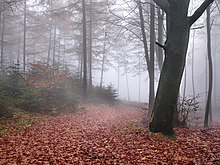
The earliest records of the Germanic peoples were recorded by the Romans, and in these works Thor is frequently referred to—via a process known as interpretatio romana (where characteristics perceived to be similar by Romans result in identification of a non-Roman god as a Roman deity)—as either the Roman god Jupiter (also known as Jove) or the Greco-Roman god Hercules. The first clear example of this occurs in the Roman historian Tacitus's late first century work Germania, where, writing about the religion of the Suebi (a confederation of Germanic peoples), he comments that "among the gods Mercury is the one they principally worship. They regard it as a religious duty to offer to him, on fixed days, human as well as other sacrificial victims. Hercules and Mars they appease by animal offerings of the permitted kind" and adds that a portion of the Suebi also venerate "Isis".[2] In this instance, Tacitus refers to the god Odin as "Mercury", Thor as "Hercules", and the god Týr as "Mars", and the identity of the "Isis" of the Suebi has been debated. In Thor's case, the identification with the god Hercules is likely at least in part due to similarities between Thor's hammer and Hercules' club.[3] In his Annals, Tacitus again refers to the veneration of "Hercules" by the Germanic peoples; he records a wood beyond the river Weser (in what is now northwestern Germany) as dedicated to him.[4]
In Germanic areas occupied by the Roman Empire, coins and votive objects dating from the 2nd and 3rd century AD have been found with Latin inscriptions referring to "Hercules", and so in reality, with varying levels of likelihood, refer to Thor by way of interpretatio romana.[5]
Post-Roman Era
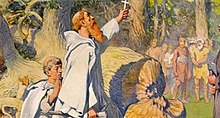
The first recorded instance of the name of the god appears in the Migration Period, where a piece of jewelry (a fibula), the Nordendorf fibula, dating from the 7th century AD and found in Bavaria, bears an Elder Futhark inscription that contains the name "Þonar", i.e. "Donar", the southern Germanic form of the god's name.[6]
According to a near-contemporary account, the Christian missionary Saint Boniface felled an oak tree dedicated to "Jove" in the 8th century, the Donar Oak in the region of Hesse, Germany.[7]
Around the second half of the 8th century, Old English tales of a figure named Thunor (Þunor) are recorded, a figure who likely refers to an Old English version of the god. In relation, Thunor is sometimes used in Old English texts to gloss Jupiter, the god may be referenced in the poem Solomon and Saturn, where the thunder strikes the devil with a "fiery axe", and the Old English expression þunnorad ("thunder ride") may refer to the god's thunderous, goat-led chariot.[8][9]
A 9th-century AD codex from Mainz, Germany, known as the Old Saxon Baptismal Vow records the name of three Old Saxon gods, UUôden (Old Saxon "Wodan"), Saxnôte, and Thunaer, by way of their renunciation as demons in a formula to be repeated by Germanic pagans formally converting to Christianity.[10]
The Kentish royal legend, probably 11th-century, contains the story of a villainous reeve of Ecgberht of Kent called Thunor, who is swallowed up by the earth at a place from then on known as þunores hlæwe (Old English 'Thunor's mound'). Gabriel Turville-Petre saw this as an invented origin for the placename demonstrating loss of memory that Thunor had been a god's name.[11]
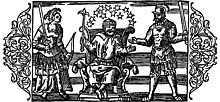
Viking Age
In the 11th century, chronicler Adam of Bremen records in his Gesta Hammaburgensis Ecclesiae Pontificum that a statue of Thor, who Adam describes as "mightiest", sits in the Temple at Uppsala in the center of a triple throne (flanked by Woden and "Fricco") located in Gamla Uppsala, Sweden. Adam details that "Thor, they reckon, rules the sky; he governs thunder and lightning, winds and storms, fine weather and fertility" and that "Thor, with his mace, looks like Jupiter". Adam details that the people of Uppsala had appointed priests to each of the gods, and that the priests were to offer up sacrifices. In Thor's case, he continues, these sacrifices were done when plague or famine threatened.[12] Earlier in the same work, Adam relays that in 1030 an English preacher, Wulfred, was lynched by assembled Germanic pagans for "profaning" a representation of Thor.[13]
Two objects with runic inscriptions invoking Thor date from the 11th century, one from England and one from Sweden. The first, the Canterbury Charm from Canterbury, England, calls upon Thor to heal a wound by banishing a thurs.[14] The second, the Kvinneby amulet, invokes protection by both Thor and his hammer.[15]
Post-Viking Age
In the 12th century, more than a century after Norway was "officially" Christianized, Thor was still being invoked by the population, as evidenced by a stick bearing a runic message found among the Bryggen inscriptions in Bergen, Norway. On the stick, both Thor and Odin are called upon for help; Thor is asked to "receive" the reader, and Odin to "own" them.[16] Also around the 12th century, iconography of the Christianizing 11th-century king Olaf II of Norway absorbed elements of the native Thor; Olaf II had become a familiarly red-bearded, hammer-wielding figure.[17]
Poetic Edda
In the Poetic Edda, compiled in the 13th century from traditional source material reaching into the pagan period, Thor appears (or is mentioned) in the poems Völuspá, Grímnismál, Skírnismál, Hárbarðsljóð, Hymiskviða, Lokasenna, Þrymskviða, Alvíssmál, and Hyndluljóð.[18]
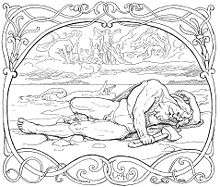
In the poem Völuspá, a dead völva recounts the history of the universe and foretells the future to the disguised god Odin, including the death of Thor. Thor, she foretells, will do battle with the great serpent during the immense mythical war waged at Ragnarök, and there he will slay the monstrous snake, yet after he will only be able to take nine steps before succumbing to the venom of the beast:
|
Benjamin Thorpe translation: |
Henry Adams Bellows translation:
|
Afterwards, says the völva, the sky will turn black before fire engulfs the world, the stars will disappear, flames will dance before the sky, steam will rise, the world will be covered in water, and then it will be raised again; green and fertile (see Prose Edda section below for the survival of the sons of Thor, who return after these events with Thor's hammer).[21]
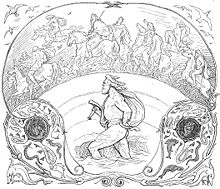
In the poem Grímnismál, the god Odin, in disguise as Grímnir, and tortured, starved and thirsty, imparts in the young Agnar cosmological lore, including that Thor resides in Þrúðheimr, and that, every day, Thor wades through the rivers Körmt and Örmt, and the two Kerlaugar. There, Grímnir says, Thor sits as judge at the immense cosmological world tree, Yggdrasil.[22]
In Skírnismál, the god Freyr's messenger, Skírnir, threatens the fair Gerðr, who Freyr is smitten with, with numerous threats and curses, including that Thor, Freyr, and Odin will be angry with her, and that she risks their "potent wrath".[23]
Thor is the main character of Hárbarðsljóð, where, after traveling "from the east", he comes to an inlet where he encounters a ferryman who gives his name as Hárbarðr (Odin, again in disguise), and attempts to hail a ride from him. The ferryman, shouting from the inlet, is immediately rude and obnoxious to Thor and refuses to ferry him. At first, Thor holds his tongue, but Hárbarðr only becomes more aggressive, and the poem soon becomes a flyting match between Thor and Hárbarðr, all the while revealing lore about the two, including Thor's killing of several jötnar in "the east" and berzerk women on Hlesey (now the Danish island of Læsø). In the end, Thor ends up walking instead.[24]
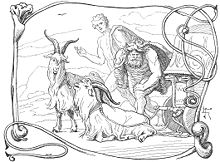
Thor is again the main character in the poem Hymiskviða, where, after the gods have been hunting and have eaten their prey, they have an urge to drink. They "sh[ake] the twigs" and interpret what they say. The gods decide that they would find suitable cauldrons at Ægir's home. Thor arrives at Ægir's home and finds him to be cheerful, looks into his eyes, and tells him that he must prepare feasts for the gods. Annoyed, Ægir tells Thor that the gods must first bring to him a suitable cauldron to brew ale in. The gods search but find no such cauldron anywhere. However, Týr tells Thor that he may have a solution; east of Élivágar lives Hymir, and he owns such a deep kettle.[25]
So, after Thor secures his goats at Egil's home, Thor and Týr go to Hymir's hall in search of a cauldron large enough to brew ale for them all. They arrive, and Týr sees his nine-hundred-headed grandmother and his gold-clad mother, the latter of which welcomes them with a horn. After Hymir—who is not happy to see Thor—comes in from the cold outdoors, Týr's mother helps them find a properly strong cauldron. Thor eats a big meal of two oxen (all the rest eat but one), and then goes to sleep. In the morning, he awakes and informs Hymir that he wants to go fishing the following evening, and that he will catch plenty of food, but that he needs bait. Hymir tells him to go get some bait from his pasture, which he expects should not be a problem for Thor. Thor goes out, finds Hymir's best ox, and rips its head off.[26]
After a lacuna in the manuscript of the poem,Hymiskviða abruptly picks up again with Thor and Hymir in a boat, out at sea. Hymir catches a few whales at once, and Thor baits his line with the head of the ox. Thor casts his line and the monstrous serpent Jörmungandr bites. Thor pulls the serpent on board, and violently slams him in the head with his hammer. Jörmungandr shrieks, and a noisy commotion is heard from underwater before another lacuna appears in the manuscript.[27]
After the second lacuna, Hymir is sitting in the boat, unhappy and totally silent, as they row back to shore. On shore, Hymir suggests that Thor should help him carry a whale back to his farm. Thor picks both the boat and the whales up, and carries it all back to Hymir's farm. After Thor successfully smashes a crystal goblet by throwing it at Hymir's head on Týr's mother's suggestion, Thor and Týr are given the cauldron. Týr cannot lift it, but Thor manages to roll it, and so with it they leave. Some distance from Hymir's home, an army of many-headed beings led by Hymir attacks the two, but are killed by the hammer of Thor. Although one of his goats is lame in the leg, the two manage to bring the cauldron back, have plenty of ale, and so, from then on, return to Ægir's for more every winter.[28]
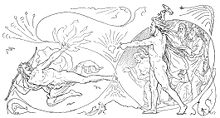
In the poem Lokasenna, the half-god Loki angrily flyts with the gods in the sea entity Ægir's hall. Thor does not attend the event, however, as he is away in the east for unspecified purposes. Towards the end of the poem, the flyting turns to Sif, Thor's wife, whom Loki then claims to have slept with. The god Freyr's servant Beyla interjects, and says that, since all of the mountains are shaking, she thinks that Thor is on his way home. Beyla adds that Thor will bring peace to the quarrel, to which Loki responds with insults.[29]
Thor arrives and tells Loki to be silent, and threatens to rip Loki's head from his body with his hammer. Loki asks Thor why he is so angry, and comments that Thor will not be so daring to fight "the wolf" (Fenrir) when it eats Odin (a reference to the foretold events of Ragnarök). Thor again tells him to be silent, and threatens to throw him into the sky, where he will never be seen again. Loki says that Thor should not brag of his time in the east, as he once crouched in fear in the thumb of a glove (a story involving deception by the magic of Útgarða-Loki, recounted in the Prose Edda book Gylfaginning)—which, he comments, "was hardly like Thor". Thor again tells him to be silent, threatening to break every bone in Loki's body. Loki responds that he intends to live a while yet, and again insults Thor with references to his encounter with Útgarða-Loki. Thor responds with a fourth call to be silent, and threatens to send Loki to Hel. At Thor's final threat, Loki gives in, commenting that only for Thor will he leave the hall, for "I know alone that you do strike", and the poem continues.[30]
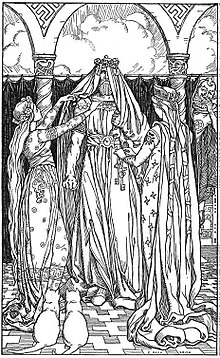
In the comedic poem Þrymskviða, Thor again plays a central role. In the poem, Thor wakes and finds that his powerful hammer, Mjöllnir, is missing. Thor turns to Loki, and tells him that nobody knows that the hammer has been stolen. The two go to the dwelling of the goddess Freyja, and so that he may attempt to find Mjöllnir, Thor asks her if he may borrow her feather cloak. Freyja agrees, and says she would lend it to Thor even if it were made of silver or gold, and Loki flies off, the feather cloak whistling.[31]
In Jötunheimr, the jötunn Þrymr sits on a barrow, plaiting golden collars for his female dogs, and trimming the manes of his horses. Þrymr sees Loki, and asks what could be amiss among the Æsir and the elves; why is Loki alone in Jötunheimr? Loki responds that he has bad news for both the elves and the Æsir—that Thor's hammer, Mjöllnir, is gone. Þrymr says that he has hidden Mjöllnir eight leagues beneath the earth, from which it will be retrieved, but only if Freyja is brought to him as his wife. Loki flies off, the feather cloak whistling, away from Jötunheimr and back to the court of the gods.[32]
Thor asks Loki if his efforts were successful, and that Loki should tell him while he is still in the air as "tales often escape a sitting man, and the man lying down often barks out lies." Loki states that it was indeed an effort, and also a success, for he has discovered that Þrymr has the hammer, but that it cannot be retrieved unless Freyja is brought to Þrymr as his wife. The two return to Freyja and tell her to put on a bridal head dress, as they will drive her to Jötunheimr. Freyja, indignant and angry, goes into a rage, causing all of the halls of the Æsir to tremble in her anger, and her necklace, the famed Brísingamen, falls from her. Freyja pointedly refuses.[33]
As a result, the gods and goddesses meet and hold a thing to discuss and debate the matter. At the thing, the god Heimdallr puts forth the suggestion that, in place of Freyja, Thor should be dressed as the bride, complete with jewels, women's clothing down to his knees, a bridal head-dress, and the necklace Brísingamen. Thor rejects the idea, yet Loki interjects that this will be the only way to get back Mjöllnir. Loki points out that, without Mjöllnir, the jötnar will be able to invade and settle in Asgard. The gods dress Thor as a bride, and Loki states that he will go with Thor as his maid, and that the two shall drive to Jötunheimr together.[34]
After riding together in Thor's goat-driven chariot, the two, disguised, arrive in Jötunheimr. Þrymr commands the jötnar in his hall to spread straw on the benches, for Freyja has arrived to be his wife. Þrymr recounts his treasured animals and objects, stating that Freyja was all that he was missing in his wealth.[35]
Early in the evening, the disguised Loki and Thor meet with Þrymr and the assembled jötnar. Thor eats and drinks ferociously, consuming entire animals and three casks of mead. Þrymr finds the behaviour at odds with his impression of Freyja, and Loki, sitting before Þrymr and appearing as a "very shrewd maid", makes the excuse that "Freyja's" behaviour is due to her having not consumed anything for eight entire days before arriving due to her eagerness to arrive. Þrymr then lifts "Freyja's" veil and wants to kiss "her". Terrifying eyes stare back at him, seemingly burning with fire. Loki says that this is because "Freyja" has not slept for eight nights in her eagerness.[35]
The "wretched sister" of the jötnar appears, asks for a bridal gift from "Freyja", and the jötnar bring out Mjöllnir to "sanctify the bride", to lay it on her lap, and marry the two by "the hand" of the goddess Vár. Thor laughs internally when he sees the hammer, takes hold of it, strikes Þrymr, beats all of the jötnar, kills their "older sister", and so gets his hammer back.[36]
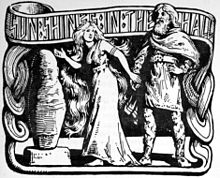
In the poem Alvíssmál, Thor tricks a dwarf, Alvíss, to his doom upon finding that he seeks to wed his daughter (unnamed, possibly Þrúðr). As the poem starts, Thor meets a dwarf who talks about getting married. Thor finds the dwarf repulsive and, apparently, realizes that the bride is his daughter. Thor comments that the wedding agreement was made among the gods while Thor was gone, and that the dwarf must seek his consent. To do so, Thor says, Alvíss must tell him what he wants to know about all of the worlds that the dwarf has visited. In a long question and answer session, Alvíss does exactly that; he describes natural features as they are known in the languages of various races of beings in the world, and gives an amount of cosmological lore.[37]
However, the question and answer session turns out to be a ploy by Thor, as, although Thor comments that he has truly never seen anyone with more wisdom in their breast, Thor has managed to delay the dwarf enough for the Sun to turn him to stone; "day dawns on you now, dwarf, now sun shines on the hall".[38]
In the poem Hyndluljóð, Freyja offers to the jötunn woman Hyndla to blót (sacrifice) to Thor so that she may be protected, and comments that Thor does not care much for jötunn women.[39]
Prose Edda, Heimskringla, and sagas
In the prologue to his Prose Edda, Snorri Sturluson euhemerises Thor as a prince of Troy, and the son of king Memnon by Troana, a daughter of Priam. Thor, also known as Tror, is said to have married the prophetess Sibyl (identified with Sif). Thor is further said here to have been raised in Thrace by a chieftain named Lorikus, whom he later slew to assume the title of "King of Thrace", to have had hair "fairer than gold", and to have been strong enough to lift ten bearskins.
The name of the aesir is explained as "men from Asia," Asgard being the "Asian city" (i.e., Troy). Alternatively, Troy is in Tyrkland (Turkey, i.e., Asia Minor), and Asialand is Scythia, where Thor founded a new city named Asgard. Odin is a remote descendant of Thor, removed by twelve generations, who led an expedition across Germany, Denmark and Sweden to Norway.
In the Prose Edda, Thor is mentioned in all four books; Prologue, Gylfaginning, Skáldskaparmál, and Háttatal.
In Heimskringla, composed in the 13th century by Snorri Sturluson, Thor or statues of Thor are mentioned in Ynglinga saga, Hákonar saga góða, Ólafs saga Tryggvasonar, and Óláfs saga helga. In Ynglinga saga chapter 5, a heavily euhemerized account of the gods is provided, where Thor is described as having been a gothi—a pagan priest—who was given by Odin (who himself is explained away as having been an exceedingly powerful magic-wielding chieftain from the east) a dwelling in the mythical location of Þrúðvangr, in what is now Sweden. The saga narrative adds that numerous names—at the time of the narrative, popularly in use—were derived from Thor.[40]
Modern folklore
Tales about Thor, or influenced by native traditions regarding Thor, continued into the modern period, particularly in Scandinavia. Writing in the 19th century, scholar Jacob Grimm records various phrases surviving into Germanic languages that refer to the god, such as the Norwegian Thorsvarme ("Thor's warmth") for lightning and the Swedish godgubben åfar ("The good old (fellow) is taking a ride") when it thunders. Grimm comments that, at times, Scandinavians often "no longer liked to utter the god's real name, or they wished to extol his fatherly goodness [...]."[41]
Thor remained pictured as a red-bearded figure, as evidenced by the Danish rhyme that yet referred to him as Thor med sit lange skæg ("Thor with the long beard") and the Frisian curse diis ruadhiiret donner regiir! ("let red-haired thunder see to that!").[41]
A Scandinavian folk belief that lightning frightens away trolls and jötnar appears in numerous Scandinavian folktales, and may be a late reflection of Thor's role in fighting such beings. In connection, the lack of trolls and ettins in modern Scandinavia is explained as a result of the "accuracy and efficiency of the lightning strokes".[42]
IV
편집Odin with a great multitude of people journeyed out of Turkland
편집Odin had second sight (투시력, 미래를 내다보는 능력), and his wife also; and from their foreknowledge he found that his name should be exalted in the northern part of the world and glorified above the fame of all other kings. Therefore, he made ready to journey out of Turkland, and was accompanied by a great multitude of people, young folk and old, men and women; and they had with them much goods of great price. And wherever they went over the lands of the earth, many glorious things were spoken of them, so that they were held more like gods than men.
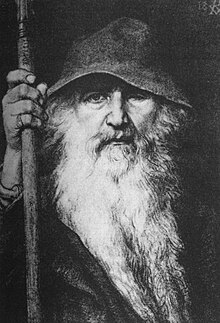
Odin (/ˈoʊd[미지원 입력]n/; from Old Norse Óðinn) is a major god in Norse mythology, the Allfather of the gods, and the ruler of Asgard.[43] Homologous with the Old English "Wōden", the Old Saxon "Wôdan" and the Old High German "Wôtan",[44] the name is descended from Proto-Germanic "*Wodanaz" or "*Wōđanaz". "Odin" is generally accepted as the modern English form of the name, although, in some cases, older forms may be used or preferred. His name is related to ōðr, meaning "fury, excitation", besides "mind", or "poetry". His role, like that of many of the Norse gods, is complex. Odin is a principal member of the Æsir (the major group of the Norse pantheon) and is associated with war, battle, victory and death, but also wisdom, Shamanism, magic, poetry, prophecy, and the hunt. Odin has many sons, the most famous of whom is the thunder god Thor. Wednesday is the unified form of Woden's day as most days of the week are named after the Norse Gods.
Poetic Edda

Völuspá
In the poem Völuspá, a völva tells Odin of numerous events reaching far into the past and future, including his own doom. The Völva describes creation, recounts the birth of Odin by his father Borr and his mother Bestla and how Odin and his brothers formed Midgard from the sea. She further describes the creation of the first human beings – Ask and Embla – by Hœnir, Lóðurr and Odin.
Amongst various other events, the Völva mentions Odin's involvement in the Æsir-Vanir War, the oedipism of Odin's eye at Mímir's Well, the death of his son Baldr. She describes how Odin is slain by the wolf Fenrir at Ragnarök, the subsequent avenging of Odin and death of Fenrir by his son Víðarr, how the world disappears into flames and, yet, how the earth again rises from the sea. She then relates how the surviving Æsir remember the deeds of Odin.
Lokasenna
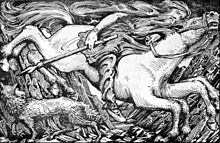
In the poem Lokasenna, the conversation of Odin and Loki starts with Odin trying to defend Gefjun and ends with his wife, Frigga, defending him. In Lokasenna, Loki derides Odin for practicing seid (witchcraft), implying it is women's work. Another example of this may be found in the Ynglinga saga where Snorri opines that men who used seid were ergi or unmanly.
Hávamál

In Rúnatal, a section of the Hávamál, Odin is attributed with discovering the runes. In a sacrifice to himself, the highest of the gods, he was hanged from the world tree Yggdrasil for nine days and nights, pierced by his own spear, in order to learn the wisdom that would give him power in the nine worlds. Nine is a significant number in Norse magical practice (there were, for example, nine realms of existence), thereby learning nine (later eighteen) magical songs and eighteen magical runes.
One of Odin's names is Ygg, and the Norse name for the World Ash —Yggdrasil—therefore could mean "Ygg's (Odin's) horse". Another of Odin's names is Hangatýr, the god of the hanged.
Hárbarðsljóð
In Hárbarðsljóð, Odin, disguised as the ferryman Hárbarðr, engages his son Thor, unaware of the disguise, in a long argument. Thor is attempting to get around a large lake and Hárbarðr refuses to ferry him.
Prose Edda


Odin had three residences in Asgard. First was Gladsheim, a vast hall where he presided over the twelve Diar or Judges, whom he had appointed to regulate the affairs of Asgard. Second, Valaskjálf, built of solid silver, in which there was an elevated place, Hlidskjalf, from his throne on which he could perceive all that passed throughout the whole earth. Third was Valhalla (the hall of the fallen), where Odin received the souls of the warriors killed in battle, called the Einherjar. The souls of women warriors, and those strong and beautiful women whom Odin favored, became Valkyries, who gather the souls of warriors fallen in battle (the Einherjar), as these would be needed to fight for him in the battle of Ragnarök. They took the souls of the warriors to Valhalla. Valhalla has five hundred and forty gates, and a vast hall of gold, hung around with golden shields, and spears and coats of mail.
Odin has a number of magical artifacts associated with him: the spear Gungnir, which never misses its target; a magical gold ring (Draupnir), from which every ninth night eight new rings appear; and two ravens Huginn and Muninn ("Thought" and "Memory"), who fly around Earth daily and report the happenings of the world to Odin in Valhalla at night. He also owned Sleipnir, an octopedal horse, who was given to Odin by Loki, and the severed head of Mímir, which foretold the future. He also commands a pair of wolves named Geri and Freki, to whom he gives his food in Valhalla since he consumes nothing but mead or wine. From his throne, Hlidskjalf (located in Valaskjalf), Odin could see everything that occurred in the universe. The Valknut (slain warrior's knot) is a symbol associated with Odin. It consists of three interlaced triangles.
Odin is an ambivalent deity. Old Norse (Viking Age) connotations of Odin lie with "poetry, inspiration" as well as with "fury, madness and the wanderer". Odin sacrificed his eye (which eye he sacrificed is unclear) at Mímir's spring in order to gain the Wisdom of Ages. Odin gives to worthy poets the mead of inspiration, made by the dwarfs, from the vessel Óð-rœrir.[45]
Odin is associated with the concept of the Wild Hunt, a noisy, bellowing movement across the sky, leading a host of slain warriors.
Consistent with this, Snorri Sturluson's Prose Edda depicts Odin as welcoming the great, dead warriors who have died in battle into his hall, Valhalla, which, when literally interpreted, signifies the hall of the slain. The fallen, the einherjar, are assembled and entertained by Odin in order that they in return might fight for, and support, the gods in the final battle of the end of Earth, Ragnarök. Snorri also wrote that Freyja receives half of the fallen in her hall Folkvang.
He is also a god of war, appearing throughout Norse myth as the bringer of victory.[출처 필요] In the Norse sagas, Odin sometimes acts as the instigator of wars, and is said to have been able to start wars by simply throwing down his spear Gungnir, and/or sending his valkyries, to influence the battle toward the end that he desires. The Valkyries are Odin's beautiful battle maidens that went out to the fields of war to select and collect the worthy men who died in battle to come and sit at Odin's table in Valhalla, feasting and battling until they had to fight in the final battle, Ragnarök. Odin would also appear on the battlefield, sitting upon his eight-legged horse Sleipnir, with his two ravens (Hugin and Munin), one on each shoulder, and two wolves (Geri and Freki) on each side of him.
Odin is also associated with trickery, cunning, and deception. Most sagas have tales of Odin using his cunning to overcome adversaries and achieve his goals, such as swindling the blood of Kvasir from the dwarves.
On September 2, 2009, an amateur archaeologist found a small silver figurine at Lejre in Denmark. It has been dated to around 900. The figurine is only two centimeters tall and shows a person sitting on a throne adorned with two beast heads and flanked by two birds on the arm-rests. The excavator interpreted the piece as a representation of Odin, Hugin and Munin.[46] Scholars specialising in Viking-Period dress and gender representations, however, pointed out that the person is dressed entirely in female attire, making it more probably a goddess such as Freya or Frigga.
Prologue
Snorri Sturluson feels compelled to give a rational account of the Æsir in the prologue of his Prose Edda. In this scenario, Snorri speculates that Odin and his peers were originally refugees from the Anatolian city of Troy, folk etymologizing Æsir as derived from the word Asia. In any case, Snorri's writing (particularly in Heimskringla) tries to maintain an essentially scholastic neutrality. That Snorri was correct was one of the last of Thor Heyerdahl's archeoanthropological theories, forming the basis for his Jakten på Odin.
Gylfaginning
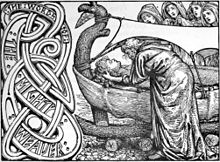
According to the Prose Edda, Odin, the first and most powerful of the Æsir, was a son of Bestla and Borr and brother of Vili and Vé. With these brothers, he cast down the frost giant Ymir and made Earth from Ymir's body. The three brothers are often mentioned together. "Vili" is the German word for "will" (English), "Vé" is the German word (Gothic wai) for woe but is more likely related to the archaic German "Wei" meaning "sacred".
Odin has fathered numerous children. With his wife, Frigg, he fathered his doomed son Baldr and the blind god Höðr. By the personification of earth, Fjörgyn or Jörð, Odin was the father of his most famous son, Thor. By the giantess Gríðr, Odin was the father of Vídar, and by Rinda he was father of Váli. Also, many royal families claimed descent from Odin through other sons. (For traditions about Odin's offspring, see Sons of Odin.)
Odin and his brothers, Vili and Ve, are attributed with slaying Ymir, the Ancient Giant, to form Midgard. From Ymir's flesh, the brothers made the earth, and from his shattered bones and teeth they made the rocks and stones. From Ymir's blood, they made the rivers and lakes. Ymir's skull was made into the sky, secured at four points by four dwarfs named East, West, North, and South. From Ymir's brains, the three Gods shaped the clouds, whereas Ymir's eyebrows became a barrier between Jotunheim (giant's home) and Midgard, the place where men now dwell. Odin and his brothers are also attributed with making humans.
After having made earth from Ymir's flesh, the three brothers came across two logs (or an ash and an elm tree). Odin gave them breath and life; Vili gave them brains and feelings; and Ve gave them hearing and sight. The first man was Ask and the first woman was Embla.
Odin was said to have learned the mysteries of seid from the Vanic goddess and völva Freyja, despite the un-warriorlike connotations of using magic.[출처 필요]
Skáldskaparmál

In section 2 of Skáldskaparmál, Odin's quest for wisdom can also be seen in his work as a farmhand for a summer, for Baugi, and his seduction of Gunnlod in order to obtain the Mead of Poetry.
In section 5 of Skáldskaparmál, the origins of some of Odin's possessions are described.
Sagas of Icelanders
Ynglinga saga
According to the Ynglinga saga:
Odin had two brothers, the one called Ve, the other Vili, and they governed the kingdom when he was absent. It happened once when Odin had gone to a great distance, and had been so long away that the people of Asa doubted if he would ever return home, that his two brothers took it upon themselves to divide his estate; but both of them took his wife Frigg to themselves. Odin soon after returned home, and took his wife back.
In Ynglinga saga, Odin is considered the 2nd Mythological king of Sweden, succeeding Gylfi and was succeeded by Njörðr.
Further, in Ynglinga saga, Odin is described as venturing to Mímir's Well, near Jötunheimr, the land of the giants. He traveled not as Odin, but as Vegtam the Wanderer, clothed in a dark blue cloak and carrying a traveler's staff. To drink from the Well of Wisdom, Odin had to sacrifice his eye (which eye he sacrificed is unclear), symbolizing his willingness to gain the knowledge of the past, present and future. As he drank, he saw all the sorrows and troubles that would fall upon men and the gods. He also saw why the sorrow and troubles had to come to men.
Mímir accepted Odin's eye and it sits today at the bottom of the Well of Wisdom as a sign that the father of the gods had paid the price for wisdom.
Other sagas

According to Njáls saga: Hjalti Skeggiason, an Icelander newly converted to Christianity, wished to express his contempt for the native gods, so he sang:
- Ever will I Gods blaspheme
- Freyja methinks a dog does seem,
- Freyja a dog? Aye! Let them be
- Both dogs together Odin and she![47]
Hjalti was found guilty of blasphemy for his infamous verse and he ran to Norway with his father-in-law, Gizur the White. Later, with Olaf Tryggvason's support, Gizur and Hjalti came back to Iceland to invite those assembled at the Althing to convert to Christianity (which happened in 999).[48][49]
The Saga of King Olaf Tryggvason, composed around 1300, describes that following King Olaf Tryggvason's orders, to prove their piety, people must insult and ridicule major heathen deities when they are newly converted into Christianity. Hallfreðr vandræðaskáld, who was reluctantly converted from paganism to Christianity by Olaf, also had to make a poem to forsake pagan deities. Below is an example:
- The whole race of men to win
- Odin's grace has wrought poems
- (I recall the exquisite
- works of my forebears);
- but with sorrow, for well did
- Viðrir's [Odin's] power please the poet,
- do I conceive hate for the first husband of
- Frigg [Odin], now I serve Christ.
- – Lausavísur 10, Whaley's translation
Flateyjarbók
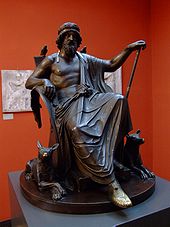
Sörla þáttr is a short narrative from a later and extended version of the Saga of Olaf Tryggvason[50] found in the Flateyjarbók manuscript, which was written and compiled by two Christian priests, Jon Thordson and Magnus Thorhalson, from the late 14th[51] to the 15th century.[52]
"Freyja was a human in Asia and was the favorite concubine of Odin, King of Asialand. When this woman wanted to buy a golden necklace (no name given) forged by four dwarves (named Dvalinn, Alfrik, Berling, and Grer), she offered them gold and silver but they replied that they would only sell it to her if she would lie a night by each of them. She came home afterward with the necklace and kept silent as if nothing happened. But a man called Loki somehow knew it, and came to tell Odin. King Odin commanded Loki to steal the necklace, so Loki turned into a fly to sneak into Freyja's bower and stole it. When Freyja found her necklace missing, she came to ask king Odin. In exchange for it, Odin ordered her to make two kings, each served by twenty kings, fight forever unless some christened men so brave would dare to enter the battle and slay them. She said yes, and got that necklace back. Under the spell, king Högni and king Heðinn battled for one hundred and forty-three years, as soon as they fell down they had to stand up again and fight on. But in the end, the great Christian lord Olaf Tryggvason arrived with his brave christened men, and whoever slain by a Christian would stay dead. Thus the pagan curse was finally dissolved by the arrival of Christianity. After that, the noble man, king Olaf, went back to his realm."[53]
Odin came to Saxland
편집They made no end to their journeying till they were come north into the land that is now called Saxland; there Odin tarried for a long space, and took the land into his own hand, far and wide.
Odin set up three of his sons for the land-wardens or rulers for Saxland
편집In that land Odin set up three of his sons for land-wardens.
Various gods and men appear as Sons of Odin or Sons of Wodan/Wotan or Sons of Woden in old Old Norse and Old High German and Old English texts.
Thor, Baldr, and Váli
Only three gods, Thor, Baldr, and Váli, are explicitly identified as sons of Odin in the Eddic poems, in the skaldic poems, in Saxo Grammaticus' Gesta Danorum, and in the Gylfaginning section of Snorri Sturluson's Prose Edda. But silence on the matter does not indicate that other gods whose parentage is not mentioned in these works might not also be sons of Odin.
Other gods called sons of Odin by Snorri Sturluson
In the Skáldskaparmál Snorri calls Víðarr a son of Odin by the giantess Gríðr. In various kennings Snorri also describes Heimdallr, Bragi, Týr and Höd as sons of Odin, information that appears nowhere else in the Edda.
For Heimdallr and Vidar there is no variant account of their father. The same may not be true for Bragi if Bragi is taken to be the skaldic poet Bragi Boddason made into a god. But Týr, according to the Eddic poem Hymiskvida, was son of the giant Hymir rather than a son of Odin. As to Höd, outside of the single statement in the kennings, Snorri makes no mention that Höd is Baldr's brother or Odin's son, though one might expect that to be emphasized. In Saxo's version of the death of Baldr, Höd, whom Saxo calls Høtherus, is a mortal and in no way related to Saxo's demi-god Baldur.
Hermód appears in Snorri's Gylfaginning as the messenger sent by Odin to Hel to seek to bargain for Baldr's release. He is called "son" of Odin in most manuscripts, but in the Codex Regius version—the Codex Regius is normally considered the best manuscript—Hermód is called sveinn Óðins 'Odin's boy', which might mean Odin's son but in the context is as likely to mean Odin's servant. However when Hermód arrives in Hel's hall, Snorri calls Baldur his brother. To confuse matters other texts know of a mortal hero named Hermód or Heremod.
An alternative list of Odin's sons
Some manuscripts of the Skáldskaparmál give, along with other material, a list of the sons of Odin, which does not altogether fit with what Snorri writes elsewhere and so is usually thought to be a later addition. As such it is omitted from some editions and translations, but it does appear in Anthony Faulkes' translation. If not by Snorri, the list is all the more valuable in that it represents an independent tradition. The text reads:
Víðarr and Nepr Váli, Áli
Þórr and Hildólfr Hermóðr, Sigi
Skjöldr, Yngvi-Freyr and Ítreksjóð
Sigi is ancestor of the Volsungs. Skjöld is ancestor of the Skjölding dynasty in Denmark. Yngvi is ancestor of a legendary Swedish Ynglings. Sæming is ancestor of a line of Norwegian kings. All appear in Snorri's pseudo-historical Prologue to the Prose Edda as sons of Odin and founders of these various lineages, perhaps all thought to be sons of Odin begotten on mortal women. See Yngvi for discussions of this personage who is mostly identical with Frey in extant texts, even though in almost all sources Frey (often called Yngvi-Frey) is instead the son of Njörd. But a Faroese ballad recorded in 1840 names Odin's son as Veraldur, this Veraldur being understood as another name of Frö, that is of Frey. See Frey for details.
Hildolf and Itreksjod are otherwise unknown as sons of Odin. The name Hildolf appears in the eddic poem Hárbardsljód applied by the ferryman Harbard to his supposed master, but Harbard is actually Odin in disguise and there is no clear reference here to a son of Odin. Hildolf and Itreksjod may have been legendary founders of families purportedly descended from Odin in traditions that have not survived.
Meili also appears in the eddic poem Hárbardsljód where Thor calls himself Odin's son, Meili's brother and Magni's father. In Snorri's Gylfaginning Ali is only another name for Vali and Nep is the father of Baldur's wife Nanna. If this list is correct in giving Odin a son named Nep, and if that Nep is identical to the father of Nanna mentioned by Snorri, then Nanna would also be Baldur's niece. But marriage between uncle and niece, though common in many cultures, does not normally appear in old Scandinavian literature.
Týr, Höd, and Bragi are conspicuously absent from this list, one reason to believe it is not from Snorri's hand.
Some manuscripts have a variant version of the list which adds Höd and Bragi to the end and replaces Yngvi-Frey with an otherwise unknown Ölldner or Ölner. This may be an attempt to bring the list into accord with Snorri, even though it still lacks Týr. Some manuscripts add additional names of sons of Odin which are otherwise unknown: "Ennelang, Eindride, Bior, Hlodide, Hardveor, Sönnöng, Vinthior, Rymur."
Founders of Dynasties
The prologue to Snorri's Edda and the alternative list discussed above both include the following:
- Sigi. He was made the ancestor of the Völsung lineage (see Völsunga saga) who were Frankish kings according to Snorri.
- Skjöld. In Snorri's Ynglinga Saga in the Heimskringla, Skjöld's wife is the goddess Gefjön and the same account occurs in most, but not all, manuscripts of the Edda. But Saxo makes Skjöld the son of Lother son of Dan. And in English tradition Skjöld (called Scyld or Sceldwa) is son of Sceafa or of Heremod when a father is named.
- Yngvi. A son of Odin in the prologue to the Edda but identified with Frey son of Njörd in the Ynglinga Saga. In both accounts this figure is made ancestor of the Yngling dynasty in Sweden (from which later kings of Norway also traced their descent).
- Sæming. Snorri's Ynglinga Saga relates that after the giantess Skaði broke off her marriage with Njörd, she "married afterwards Odin, and had many sons by him, of whom one was called Sæming" from whom Jarl Hákon claimed descent. Snorri then quotes a relevant verse by the poet Eyvindr skáldaspillir. However in his preface to the Heimskringla Snorri says that Eyvindr's Háleygjatal which reckoned up the ancestors of Jarl Hákon brought in Sæming as son of Yngvi-Frey. Snorri may have slipped here, thinking of the Ynglings. As to the many sons, it is possible that some of the otherwise unknown sons in the previous section may be sons purportedly born by Skadi.
According to Herrauds saga:
- Gauti. Gauti's son Hring ruled Östergötland (East Götaland), so Gauti appears to be the eponym of the Geatas in Beowulf. Some versions of the English royal line of Wessex add names above that of Woden, purportedly giving Woden's ancestry, though the names are now usually thought be in fact another royal lineage that has been at some stage erroneously pasted onto the top of the standard genealogy. Some of these genealogies end in Geat, whom it is reasonable to think might be Gauti. The account in the Historia Britonum calls Geat a son of a god which fits. But Asser in his Life of Alfred writes instead that the pagans worshipped this Geat himself for a long time as a god. In Old Norse texts Gaut is itself a very common byname for Odin. Jordanes in The origin and deeds of the Goths traces the line of the Amelungs up to Hulmul son of Gapt, purportedly the first Gothic hero of record. This Gapt is felt by many commentators to be an error for Gaut or Gauti.
According to Hervarar saga ok Heidreks konungs ("The Saga of Hervor and King Heidrek") versions H and U:
- Sigrlami. He was son of Odin and king of Gardariki. His son Svafrlami succeeded him. Svafrlami forced the dwarves Dvalinn and Durin to forge himself a superb sword, Tyrfing. They did so and cursed it. In version R Sigrlami takes on the role of Svafrlami and his parentage is not given.
In the prologue to the Edda Snorri also mentions sons of Odin who ruled among the continental Angles and Saxons and provides information about their descendants that is identical or very close to traditions recorded in the Anglo-Saxon Chronicle. Snorri may here be dependent on English traditions. The sons mentioned by both Snorri and the Anglo-Saxon Chronicle are:
- Vegdagr/Wægdæg/Wecta. According to Snorri Vegdeg ruled East Saxony. The Anglo-Saxon Chronicle does not make it clear that Wægdæg and Wecta are identical (or perhaps it is Snorri or a source who has wrongly conflated Wecta with Wægdæg). In the Anglo-Saxon Chronicle the Wecta form of the name heads the lineage of the kings of Kent (of whom Hengest is traditionally the first) and the Wægdæg form of the name heads the lineage of the kings of Deira.
- Beldeg. According to Snorri's prologue Beldeg was identical to Baldur and ruled in Westphalia. There is no independent evidence of the identification of Beldeg with Baldur. From Beldeg the Anglo-Saxon Chronicle traces the kings of Bernicia and Wessex.
Other Anglo-Saxon genealogies mention:
- Weothulgeot or Whitlæg. According to the genealogies in the Anglian collection, Weothulgeot was ancestor to the royal house of Mercia and the father of Whitlæg. According to the Historia Brittonum, Weothulgeot was father of Weaga who was father of Whitlæg. But the two Anglo-Saxon Chronicle versions of this genealogy include neither Weothulgeot nor Weaga but make Whitlæg himself the son of Woden. In all versions Whitlæg is father of Wermund father of Offa of Angel. According to the Old English poem Widsith Offa ruled over the continental Angels. Saxo, though not mentioning Whitlæg's parentage, introduces Whitlæg as a Danish king named Wiglek who was the slayer of Amleth (Hamlet).
- Casere. He was made ancestor to the royal house of East Anglia and is thought to represent none other than Julius Caesar.
- Winta. He was made ancestor to the royal house of Lindsey/Lindisfarne. This genealogy is found only in the Anglian collection, not in the Anglo-Saxon Chronicle.
- Seaxnēat. Made ancestor of the kings of Essex. He is mentioned as Saxnôte alongside Uuôden (Wodan) and Thunaer (Thunor) in the Old Dutch/Saxon Baptismal Vow. He was originally at the top of the Essex pedigree, and only later was made son of Woden to harmonize with the other Anglo-Saxon royal pedigrees.
Froger
Saxo Grammaticus' Gesta Danorum (Book 4) speaks of Froger, the King of Norway, who was a great champion. Saxo relates:
According to some, he was the son of Odin, and when he begged the immortal gods to grant him a boon, received the privilege that no man should conquer him, save he who at the time of the conflict could catch up in his hand the dust lying beneath Froger's feet.
King Fródi the Active of Denmark, still a young man, learning of the charm, begged Froger to give him lessons in fighting. When the fighting court had been marked off, Fródi entered with glorious gold-hilted sword and clad in a golden breastplate and helmet. Fródi then begged a boon from Froger, that they might change positions and arms. Froger agreed. After the exchange, Fródi caught up some dust from where Froger had been standing and then quickly defeated Froger in battle and slew him.
See also
External links
- Variant forms of the alternative list of Odin's sons:
- Sagnanet: AM 745 4to: Edda: 46r (short version.)
- Sagnanet: AM 744 4to: Edda: 61v (medium version.)
- Sagnanet: AM 746 4to: Edda: 80 (medium version.)
- Sagnanet: PT312. A1; Edda Islandorum: p. 271 (long version.)
This is a Family tree of the Norse gods showing the most important gods and goddesses in Norse mythology.
Ymir is the first being, a giant who was born from venom that dripped from the icy rivers Élivágar in the primordial void of Ginnungagap.
Æsir are indicated with boldface and Vanir are indicated with italics. Others are Jötnar.
Aesir
Vanir and Loki
Sources
- Faulkes, Anthony (Trans.) (1995). Edda. Everyman. ISBN 0-460-87616-3
- Lindow, John (2002). Norse Mythology: A Guide to the Gods, Heroes, Rituals, and Beliefs. Oxford University Press. ISBN 0-19-515382-0
- Grimes, Heilan Yvette (2010). 《The Norse Myths》. Boston: Hollow Earth Publishing. 311–313쪽. ISBN 1879196026. 2013년 6월 3일에 확인함.
Vegdeg as the ruler of East Saxland
편집One was named Vegdeg: he was a mighty king and ruled over East Saxland;
- his son was Vitgils;
- his sons were Vitta, Heingistr's father, and Sigarr,
- father of Svebdeg, whom we call Svipdagr.
Beldeg as the ruler of Westphalia
편집The second son of Odin was
[p. 8]
Beldeg, whom we call Baldr: he had the land which is now called Westphalia.
- His son was Brandr,
- his son Frjodigar, (whom we call Frodi),
- his son Freovin,
- his son Uvigg,
- his son Gevis (whom we call Gave).
Sigi as the ruler of Frankland, and Volsungs
편집Odin's third son is named Sigi,
- his son Rerir.
These the forefathers ruled over what is now called Frankland; and thence is descended the house known as Volsungs. From all these are sprung many and great houses.
Odin came into Reidgothland
편집Then Odin began his way northward, and came into the land which they called Reidgothland; and in that land he took possession of all that pleased him.
Odin set up Skjoldr as the ruler of Reidgothland or Jutland, and Skjoldungs
편집He (= Odin) set up over the land that son of his called Skjoldr,
- whose son was Fridleifr;
--and thence descends the house of the Skjoldungs: these are the kings of the Danes. And what was then called Reidgothland is now called Jutland.
V
편집Æsir (Odin and his company) came into Sweden and met with Gylfi
편집After that he (= Odin) went northward, where the land is called Sweden; the king there was named Gylfi. When the king learned of the coming of those men of Asia, who were called Æsir, he (= Gylfi) went to meet them,
Odin and Gylfi ruled Sweden together
편집and (Gylfi) made offer to them that Odin should have such power in his realm as he himself wielded. And such well-being followed ever upon their footsteps, that in whatsoever lands they dwelt were good seasons and peace; and all believed that they caused these things, for the lords of the land perceived that they were unlike other men whom they had seen, both in fairness and also in wisdom.
Odin chose Sigtun as his city and set up chieftains and twelve doomsmen
편집The fields and the choice lands in that place seemed fair to Odin, and he chose for himself the site of a city which is now called Sigtun. There he established chieftains in the
[p. 9]
fashion which had prevailed in Troy; he set up also twelve head-men to be doomsmen (= judge; umpire) over the people and to judge the laws of the land; and he ordained also all laws as, there had been before, in Troy, and according to the customs of the Turks.
Odin reached the sea and set up Sæmingr as the ruler of Norway
편집After that he went into the north, until he was stopped by the sea, which men thought lay around all the lands of the earth; and there he set his son over this kingdom, which is now called Norway. This king was Sæmingr;
Odin's descendants: Kings of Norway, Haleygjatal and Ynglings
편집the kings of Norway trace their lineage from him,
and so do also the jarls and the other mighty men, as is said in the Haleygjatal.
Odin had with him one of his sons called Yngvi, who was king in Sweden after him; and those houses come from him that are named Ynglings.
Æsir 's wives and descendants, spreading the tongue of Asia
편집The Æsir took wives of the land for themselves, and some also for their sons; and these kindreds became many in number, so that throughout Saxland, and thence all over the region of the north, they spread out until their tongue, even the speech of the men of Asia, was the native tongue over all these lands.
Therefore men think that they can perceive, from their forefathers' names which are written down, that those names belonged to this tongue, and that the Æsir brought the tongue hither into the northern region, into Norway and into Sweden, into Denmark and into Saxland. But in England there are ancient lists of land-names and place-names which may show that these names came from another tongue than this.
[p. 13]
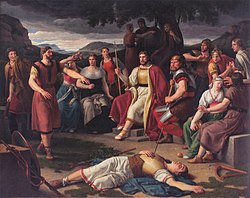
In Old Norse, áss (or ǫ́ss, ás, plural æsir; feminine ásynja, plural ásynjur) is the term denoting a member of the principal pantheon in the indigenous Germanic religion known as Norse paganism. This pantheon includes Odin, Frigg, Thor, Baldr and Týr. The second pantheon comprises the Vanir. In Norse mythology, the two pantheons wage the Æsir-Vanir War, which results in a unified pantheon.
The cognate term in Old English is ōs (plural ēse) denoting a deity in Anglo-Saxon paganism. The Old High German is ans, plural ensî.[68]
The Gothic language had ans- (based only on Jordanes who glossed anses with uncertain meaning, possibly 'demi-god' and presumably a Latinized form of actual plural *anseis).[69]
The reconstructed Proto-Germanic form is *ansuz (plural *ansiwiz). The a-rune ![]() 〈ᚫ〉. 《New International Encyclopedia》. 1905. was named after the æsir.
〈ᚫ〉. 《New International Encyclopedia》. 1905. was named after the æsir.
Unlike the Old English word god (and Old Norse goð), the term ōs (áss) was never adopted into Christian use and survived only in a secularized meaning of "pole, beam, stave, hill" or "yoke".
Etymology
Æsir is the plural of áss, óss "god" (gen. āsir) which is attested in other Germanic languages, e.g., Old English ōs (gen. pl. ēsa) and Gothic (as reported by Jordanes) anses "half-gods". These all stem from Proto-Germanic *ansis ~ ansuz, which itself comes from Proto-Indo-European *h₂énsus (gen. h₂n̥sóus) "life force" (cf. Avestan aŋhū "lord; lifetime", ahura "godhood", Sanskrit ásu "life force",[70] ásura "god" (< *h₂n̥suró)). It is widely accepted that this word is further related to *h₂ens- "to engender" (cf. Hittite hass- "to procreate, give birth", Tocharian B ās- "to produce").[71]
Old Norse áss has the genitive áss or ásar, the accusative æsi and ásu. In genitival compounds, it takes the form ása-, e.g. in Ása-Þórr "Thor of the Aesir", besides ás- found in ás-brú "gods' bridge" (the rainbow), ás-garðr, ás-kunnigr "gods' kin", ás-liðar "gods' leader", ás-mogin "gods' might" (especially of Thor), ás-móðr "divine wrath" etc. Landâs "national god" (patrium numen) is a title of Thor, as is allmáttki ás "almighty god", while it is Odin who is "the" ás.
The feminine's -ynja suffix is known from a few other nouns denoting female animals, such as apynja "female monkey", vargynja "she-wolf". The word for "goddess" is not attested outside of Old Norse.
The latinization of Danish Aslak as Ansleicus[72] indicates that the nasalization in the first syllable persisted into the 9th century.
The cognate Old English form to áss is ōs, preserved only as a prefix Ōs- in personal names (e.g. Oscar, Osborne, Oswald) and some place names, and as the genitive plural ēsa (ēsa gescot and ylfa gescot, "the shots of anses and of elves", jaculum divorum et geniorum). In Old High German and Old Saxon the word is only attested in personal and place names, e.g. Ansebert, Anselm, Ansfrid, Vihans. Jordanes has anses for the gods of the Goths.[73]
Norse mythology
The interaction between the Æsir and the Vanir has provoked an amount of scholarly theory and speculation. While other cultures have had "elder" and "younger" families of gods, as with the Titans versus the Olympians of ancient Greece, the Æsir and Vanir were portrayed as contemporaries. The two clans of gods fought battles, concluded treaties, and exchanged hostages (Freyr and Freyja are mentioned as such hostages).
An áss like Ullr is almost unknown in the myths, but his name is seen in a lot of geographical names, especially in Sweden, and may also appear on the 3rd century Thorsberg chape, suggesting that his cult was widespread in prehistoric times.
The names of the first three Æsir in Norse mythology, Vili, Vé and Odin all refer to spiritual or mental state, vili to conscious will or desire, vé to the sacred or numinous and óðr to the manic or ecstatic.
Æsir and Vanir
A second clan of gods, the Vanir, is also mentioned in Norse mythology: the god Njord and his children, Freyr and Freyja, are the most prominent Vanir gods who join the Æsir as hostages after a war between Æsir and Vanir. The Vanir appear to have mainly been connected with cultivation and fertility and the Æsir were connected with power and war. The Æsir and Vanir may correspond to the Indo-Iranian and vedic Asuras and Devas.
In the Eddas, however, the word Æsir is used for gods in general, while Asynjur is used for the goddesses in general. For example, in the poem Skírnismál, Freyr was called "Prince of the Æsir". In the Prose Edda, Njord was introduced as "the third among the Æsir", and among the Asynjur, Freyja is always listed second only to Frigg.
In surviving tales, the origins of many of the Æsir are unexplained. Originally, there are just three: Odin and his brothers Vili and Vé. Odin's sons by giantesses are naturally counted as Æsir. Heimdall and Ullr's connection with the Æsir is not clearly mentioned. Loki is a jötunn with no evidence of being worshipped, and Njord is a Vanir hostage, but they are often ranked among the Æsir.
Given the difference between their roles and emphases, some scholars have speculated that the interactions between the Æsir and the Vanir reflect the types of interaction that were occurring between social classes (or clans) within Norse society at the time.[74] According to another theory, the Vanir (and the fertility cult associated with them) may be more archaic than that of the more warlike Æsir, such that the mythical war may mirror a half-remembered religious conflict.[75] Another historical theory is that the inter-pantheon interaction may be an apotheosization of the conflict between the Romans and the Sabines.[76] Finally, the noted comparative religion scholar Mircea Eliade speculated that this conflict is actually a later version of an Indo-European myth concerning the conflict between and eventual integration of a pantheon of sky/warrior/ruler gods and a pantheon of earth/economics/fertility gods, with no strict historical antecedents.[77]
List of Æsir
Gylfaginning (20.ff) gives a list of twelve male aesir, not including Odin their chief, nor including Loki, "whom some call the backbiter of the asas":
Then said Gangleri: Which are the Æsir in whom it is man’s duty to believe? Har answers: Twelve are the Æsir of the race of gods. Then said Jafnhar: The Asynjur are not less holy and they are not less capable. Then said Thrithi: Odin is the greatest and oldest of the Æsir. ... Frigg is his wife, and she knows the fate of men, although she tells not thereof. ...
- (21.) Thor is the foremost of them. He is called Asa-Thor, or Oku-Thor. He is the strongest of all gods and men, and rules over the realm which is called Thrudvang.
- (22.) Odin's second son is Balder
- (23.) the third asa is he who is called Njord.
- (24.) Njord, in Noatun, afterward begat two children: a son, by name Freyr, and a daughter, by name Freyja. They were fair of face, and mighty. Freyr is arguably the most famous of the asas. He rules over rain and sunshine, and over the fruits of the earth. It is good to call on him for harvests and peace. He also sways the wealth of men. Freyja is the most famous of the goddesses. ...
- (25.) There is yet an asa, whose name is Tyr. He is very daring and stout-hearted. He sways victory in war, wherefore warriors should call on him.
- (26.) Bragi is the name of another of the asas. He is famous for his wisdom, eloquence and flowing speech.
- (27.) Heimdall is the name of one. He is also called the white-asa. He is great and holy; born of nine maidens, all of whom were sisters. He is also called Hallinskide and Gullintanne, for his teeth were of gold.
- (28.) Hoder hight one of the asas, who is blind, but exceedingly strong; and the gods would wish that this asa never needed to be named, for the work of his hand will long be kept in memory both by gods and men.
- (29.) Vidar is the name of the silent asa. He has a very thick shoe, and he is the strongest next after Thor. From him the gods have much help in all hard tasks.
- (30.) Ale, or Vale, is the son of Odin and Rindr. He is daring in combat, and a good shot.
- (31.) Ullr is the name of one, who is a son of Sif, and a step-son of Thor. He is so good an archer, and so fast on his skees, that no one can contend with him. He is fair of face, and possesses every quality of a warrior. Men should invoke him in single combat.
- (32.) Forseti is a son of Balder and Nanna, Nep's daughter. He has in heaven the hall which hight Glitner. All who come to him with disputes go away perfectly reconciled. Just to listen to People's Future. No better tribunal is to be found among gods and men. ...
(33.) There is yet one who is numbered among the asas, but whom some call the backbiter of the asas. He is the originator of deceit, and the disgrace of all gods and men. His name is Loki, or Lopt. ... His wife hight Sigyn, and their son, Nare, or Narfe.
Corresponding to the fourteen Æsir listed above, section 36 lists fourteen asynjur:
Ganglere asked: Which are the goddesses? Har answered:
- Frigg is the first; she possesses the right lordly dwelling which is called Fensaler.
- The second is Saga, who dwells in Sokvabek, and this is a large dwelling.
- The third is Eir, who is the best leech.
- The fourth is Gefjun, who is a may, and those who die maids become her hand-maidens.
- The fifth is Fulla, who is also a may, she wears her hair flowing and has a golden ribbon about her head; she carries Frigg's chest, takes care of her shoes and knows her secrets.
- The sixth is Freyja, who is ranked with Frigg. She is wedded to the man whose name is Oder; their daughter's name is Hnos, and she is so fair that all things fair and precious are called, from her name, Hnos. Oder went far away. Freyja weeps for him, but her tears are red gold. Freyja has many names, and the reason therefor is that she changed her name among the various nations to which she came in search of Oder. She is called Mardol, Horn, Gefn, and Syr. She has the necklace Brising, and she is called Vanadis.
- The seventh is Sjöfn, who is fond of turning men's and women's hearts to love, and it is from her name that love is called Sjafne.
- The eighth is Lofn, who is kind and good to those who call upon her, and she has permission from Alfather or Frigg to bring together men and women, no matter what difficulties may stand in the way; therefore "love" is so called from her name, and also that which is much loved by men.
- The ninth is Var. She hears the oaths and troths that men and women plight to each other. Hence such vows are called vars, and she takes vengeance on those who break their promises.
- The tenth is Vör, who is so wise and searching that nothing can be concealed from her. It is a saying that a woman becomes vor (ware) of what she becomes wise.
- The eleventh is Syn, who guards the door of the hall, and closes it against those who are not to enter. In trials she guards those suits in which anyone tries to make use of falsehood. Hence is the saying that "syn is set against it," when anyone tries to deny ought.
- The twelfth is Hlin, who guards those men whom Frigg wants to protect from any danger. Hence is the saying that he hlins who is forewarned.
- The thirteenth is Snotra, who is wise and courtly. After her, men and women who are wise are called Snotras.
- The fourteenth is Gna, whom Frigg sends on her errands into various worlds. She rides upon a horse called Hofvarpner, that runs through the air and over the sea. Once, when she was riding, some vanir saw her faring through the air. [...]
Sol and Bil are numbered among the goddesses, but their nature has already been described.
The A-rune
The a-rune ![]() 〈ᚫ〉. 《New International Encyclopedia》. 1905., Younger Futhark ᚬ was probably named after the Æsir. The name in this sense survives only in the Icelandic rune poem as Óss, referring to Odin in particular, identified with Jupiter:
〈ᚫ〉. 《New International Encyclopedia》. 1905., Younger Futhark ᚬ was probably named after the Æsir. The name in this sense survives only in the Icelandic rune poem as Óss, referring to Odin in particular, identified with Jupiter:
 〈ᚬ〉. 《New International Encyclopedia》. 1905. Óss er algingautr / ok ásgarðs jöfurr, / ok valhallar vísi. / Jupiter oddviti.
〈ᚬ〉. 《New International Encyclopedia》. 1905. Óss er algingautr / ok ásgarðs jöfurr, / ok valhallar vísi. / Jupiter oddviti. - "Óss is Aged Gautr / and prince of Asgard / and lord of Valhalla / chieftain Jupiter."
The name of 𐌰 a in the Gothic alphabet is ahsa. The common Germanic name of the rune may thus have either been ansuz "God, one of the Æsir", or ahsam "ear (of corn)"
Asleikr
The personal names Old Norse Ásleikr (Latinized Ansleicus, modern Axel), Old English Óslác (modern "Hasluck") and Old High German Ansleh may continue the term for a sacrificial performance for the gods in early Germanic paganism (*ansu-laikom). Grimm's Deutsches Wörterbuch (s.v. "Leich") compares *laikom to the meaning of Greek χορος, denoting first the ceremonial procession to the sacrifice, but also ritual dance and hymns pertaining to religious ritual. Hermann (1906)[78] identifies as such *ansulaikom the victory songs of the Batavi after defeating Quintus Petillius Cerialis in the Batavian rebellion of 69 AD (according to Tacitus' account), and also the "nefarious song" accompanied by "running in a circle" around the head of a decapitated goat sacrificed to (he presumes) Wodan, sung by the Lombards at their victory celebration in 579 according to the report of Pope Gregory the Great (Dialogues ch. 28).
Personal names
| This section does not cite any references or sources.(March 2008) |
Theophoric Anglo-Saxon names containing the os element: Osmund, Osburh, Oslac (Danish Axel), Oswald, Oswiu, Oswin, Osbert, Oswudu, Osred, Oslaf, Offa (from Osfrid), Oesa (i-mutated from a *Ós-i-), Oscar (Anglo-Saxon form of Ásgeir). These names were notably popular in the Bernician dynasty. Still-current are the surname Osgood and Osborn.
As occurs in many Scandinavian names: Asbjørn, Asgeir (Asger, Asker), Asmund, Astrid, Asdîs, Asgautr, Aslaug, Åse etc. Gothic has Ansila and Ansemund, and Old High German Anso, Anshelm, Anshilt, Anspald, Ansnôt.
As also occurs in some English names. In 874, King Asketil was one of four Viking nobles who sacked Repton, the capital of Mercia, England. As 'ketil' means 'cauldron' (from whence the English word 'kettle' is derived), his name means 'God's cauldron'. The English surname Astle is derived from his name, however it is not related to the name Astley. Less common alternative spellings of Astle include Astel, Astell, Astill, Astyll and Astull.
Ásatrú
Ásatrú, meaning "faith in the Æsir", is a new religious movement of polytheistic reconstructionism based on Norse paganism. As of 2007, Ásatrú is a religion officially recognized by the governments of Iceland, Norway, Denmark,[not in citation given][79] and Sweden.
In spite of the literal meaning of Ásatrú, most adherents do not emphasize worship of the Æsir in particular. The Icelandic Ásatrúarfélagið describes Ásatrú as "Nordic pantheism" involving "belief in the Icelandic/Nordic folklore" including all the "spirits and entities" besides "gods and other beings" this entails.[80] The American Asatru Folk Assembly defines Ásatrú as "an expression of the native, pre-Christian spirituality of Europe" postulating it as "native European religion" in general "just as there is Native American religion and native African religion".[81]
See also
References
- DuBois, Thomas A. (1999). Nordic Religions in the Viking Age. Philadelphia, PA: University of Pennsylvania Press. ISBN 0-8122-1714-4
- Dumézil, Georges (1973). Gods of the Ancient Northmen. Edited by Einar Haugen; Introduction by C. Scott Littleton and Udo Strutynski. Berkeley, CA: University of California Press. ISBN 0-520-02044-8
- Grimm, Jacob. Teutonic Mythology, ch. 2
- Munch, P. A. (1926). Norse Mythology: Legends of Gods and Heroes. In the revision of Magnus Olsen; translated from the Norwegian by Sigurd Bernhard Hustvedt. New York: The American-Scandinavian Foundation; London: H. Milford, Oxford University Press.
- Orchard, Andy (2002). Cassell's Dictionary of Norse Myth and Legend. London: Cassell. ISBN 0-304-36385-5
- Turville-Petre, Gabriel (1964). Myth and Religion of the North: The Religion of Ancient Scandinavia. New York: Holt, Rinehart and Winston. ISBN 0-8371-7420-1
External links
- Viktor Rydberg's "Teutonic Mythology: Gods and Goddesses of the Northland" e-book
- W. Wagner's "Asgard and the Home of the Gods" e-book
- "Myths of Northern Lands" e-book by H. A. Guerber
- Peter Andreas Munch's "Norse Mythology: Legends of Gods and Heroes" e-book
- Bartleby: American Heritage Dictionary: Indo-European roots: ansu
Next: Gylfaginning
주해
편집
주석
편집- ↑ On the red beard and the use of "Redbeard" as an epithet for Thor, see H.R. Ellis Davidson, Gods and Myths of Northern Europe, 1964, repr. Harmondsworth, Middlesex: Penguin, 1990, ISBN 0-14-013627-4, p. 85, citing the Saga of Olaf Tryggvason in Flateyjarbók, Saga of Erik the Red, and Flóamanna saga. The Prologue to the Prose Edda says ambiguously that "His hair is more beautiful than gold."
- ↑ Birley (1999:42).
- ↑ Birley (1999:107).
- ↑ Birley (1999:42 and 106—107).
- ↑ Simek (2007:140—142).
- ↑ Simek (2007:235—236).
- ↑ Simek (2007:238) and Robinson (1916:63).
- ↑ Turville-Petre (1964:99)
- ↑ See North (1998:238—241) for þunnorad and tales regarding Thunor, see Encyclopædia Britannica (1910:608) regarding usage of Thunor as an Old English gloss for Jupiter and Tiw employed as a gloss for Mars.
- ↑ Simek (2007:276).
- ↑ Turville-Petre (1964:99–100); variant texts in mss. Stowe 944, Cotton Caligula A. xiv, London, Lambeth Palace 427.
- ↑ Orchard (1997:168—169).
- ↑ North (1998:236).
- ↑ McLeod, Mees (2006:120).
- ↑ McLeod, Mees (2006:28).
- ↑ McLeod, Mees (2006:30).
- ↑ Dumézil (1973:125).
- ↑ Larrington (1999:320).
- ↑ Thorpe (1907:7).
- ↑ Bellows (1923:23).
- ↑ Larrington (1999:11—12).
- ↑ Larrington (1999:57).
- ↑ Larrington (1999:66).
- ↑ Larrington (1999:69-75).
- ↑ Larrington (1999:78—79).
- ↑ Larrington (1999:79—80).
- ↑ Larrington (1999:81).
- ↑ Larrington (1999:82—83).
- ↑ Larrington (1999:84 and 94).
- ↑ Larrington (1999:94—95).
- ↑ Larrington (1999:97).
- ↑ Larrington (1999:97–98).
- ↑ Larrington (1999:98).
- ↑ Larrington (1999:99).
- ↑ 가 나 Larrington (1999:100).
- ↑ Larrington (1999:101).
- ↑ Larrington (1999:109—113). For Þrúðr hypothesis, see Orchard (1997:164—165).
- ↑ Larrington (1999:113).
- ↑ Larrington (1999:254).
- ↑ Hollander (2007:10—11).
- ↑ 가 나 Grimm (1882:166—177).
- ↑ See Lindow (1978:89), but noted as early as Thorpe (1851:154) who states "The dread entertained by Trolls for thunder dates from the time of paganism, Thor [ . . . ] being the deadly foe of their race".
- ↑ New York Times
- ↑ Brian Murdoch (editor) (2004). 《German Literature of the Early Middle Ages》. Camden House Publishing. 62쪽. ISBN 978-1-57113-240-6.
- ↑ Skaldskaparmal, in Edda. Anthony Faulkes, Trans., Ed. (London: Everyman, 1996).
- ↑ 틀:Da iconJyllands-Posten, "Sensationelt fund af Odin-figur", November 14, 2009.
- ↑ Njál's Saga or The Story of Burnt Njal, George W. DaSent transl. (1861).
- ↑ Craigie, William Alexanger (1914). 《The Religion Of Ancient Scandinavia》.
- ↑ T. Kendrick, "History of the Vikings" (1930), p.349, 350.
- ↑ The Younger Edda. Rasmus B. Anderson transl. (1897) Chicago: Scott, Foresman & Co. (1901).
- ↑ Lindow, John. Norse Mythology: A Guide to the Gods, Heroes, Rituals, and Beliefs, pages 280–281. (2001) Oxford: Oxford University Press. ISBN 0-19-515382-0.
- ↑ Rasmus B. Anderson, Introduction to The Flatey Book. Norræna Society, London (1908).
- ↑ This short story is also known as "The Saga of Högni and Hedinn". English translation can be found at Northvegr: Three Northern Love Stories and Other Tales.
- ↑ Vafþrúðnismál (29).
- ↑ 가 나 다 라 마 Gylfaginning (6).
- ↑ Lindow (2002:169).
- ↑ Gylfaginning (9).
- ↑ Skáldskaparmál (19).
- ↑ Faulkes (1995:69).
- ↑ Faulkes (1995:25-26).
- ↑ Faulkes (1995:77).
- ↑ Skáldskaparmál (24).
- ↑ Lokasenna (58).
- ↑ Opinion is divided on Tyr's family relationships. Hymiskviða mentions giant Hymir as his father, but the Prose Edda mentions his father Odin.
- ↑ Skáldskaparmál (4).
- ↑ Skáldskaparmál (21).
- ↑ Skáldskaparmál (17).
- ↑ Jacob Grimm, Deutsche Mythologie
- ↑ Grimm, ch. 2
- ↑ [1]
- ↑ D.Q. Adams, "King", in Encyclopedia of Indo-European Culture (London: Fitzroy Dearborn, 1997), 330.
- ↑ the name of a Danish Viking converted to Christianity in AD 864 according to the Miracles de St. Riquier
- ↑ "Tum Gothi, magna potiti per loca victoria, jam proceres suos quasi qui fortuna vincebant, non puros homines, sed semideos, id est anses vocavere." (ch. 13)
- ↑ Dumézil, 3-4, 18; Turville-Petre, 159-162.
- ↑ This argument was first suggested by Wilhelm Mannhardt in 1877 (as described in Dumézil, xxiii and Munch, 288). On a similar note, Marija Gimbutas argues that the Æsir and the Vanir represent the displacement of an indigenous Indo-European group by a tribe of warlike invaders (in following her Kurgan hypothesis). See her case in The Living Goddess for more details.
- ↑ Turville-Petre, 161. See especially ff. 37.
- ↑ See this pattern discussed in Eliade's Patterns in Comparative Religion - Section II (30) - The Supplanting of Sky Gods by Fecundators. New York: Sheed & Ward, 1958. Supporting this position, Turville-Petre notes, "In one civilization, and at one time, the specialized gods of fertility might predominate, and in another the warrior or the god-king. The highest god owes his position to those who worship him, and if they are farmers, he will be a god of fertility, or one of the Vanir" (162).
- ↑ Paul Hermann, Deutsche Mythologie in Gemeinverständlicher Darstellung (1906) p. 342; also in Altdeutsche Kultgebräuche, Jena (1928)
- ↑ Kirkeministeriet
- ↑ The Icelandic version has "Ásatrú is a pagan tradition based on tolerance, honesty, magnanimity and respect for nature and all life." (Ásatrú eða heiðinn siður byggir á umburðarlyndi, heiðarleika, drengskap og virðingu fyrir náttúrunni og öllu lífi.) (2006)
- ↑ "The soul of Asatru, however, is not confined to the Scandinavian model, but encapsulates the belief of all the Germanic peoples. Indeed, Asatru reflects the deeper religiosity common to virtually all the nations of Europe." runestone.org, accessed December 2007